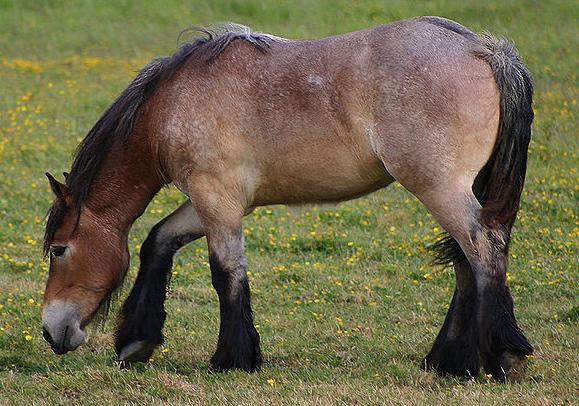The Belgian draught horse
The prehistoric Belgian horse from the Meuse, whose bones were found in the Lesse caves, must have been 1.40 m tall. The simultaneous existence of strong-boned horses, perhaps the ancestors of the now extinct Flanders horse, used as a steed in the Middle Ages, is accepted. They were massive, measuring between 1.60 and 1.75 m. Before efforts were made to standardize the Belgian horse breed, until the 19th century it was divided into varieties specific to each region.

These included
- The Ardennes variety with the Big Ardennes (actually Brabançons), and small Ardennes from Condroz.
- The Condruzienne variety (Condruzien, Condroz or Belge Moyen horse), a large, fast draft horse that was an intermediate form between the Brabançon and the petit Ardennes.
- The Brabançonne variety (Brabançon, Brabant or Grand Belge horse), with 3 breeding centers in the former province of Brabant in central Belgium
Horses from the Dendre valley, called “Gros de la Dendre”, heavy, stocky with strong bones and powerful muscles. Light bay coat. The origin of the famous d’Orange line.
Horses from the Nivelles region, known as “Gris de Nivelles”, more elegant and distinguished than the above, with finer limbs. Gray, auber or roan coat. Bayard provided the most important lineage.
The horses of the Méhaigne valley, known as “Colosses de la Méhaigne”, heavy, very bony, angular, and very energetic. Coat: dark bay. One of the main stallions was Jean I.
The “cheval de Trait Belge” (Belgian draught horse) is the result of a long process of selection of the old Brabant horse breed. Among the founders of the mid-twentieth-century lines, Albin d’Hor passed on a type of rare nobility, with an extraordinarily powerful hindquarter.
The Trait Belge played an important role in the creation of numerous Trait Lourd breeds (Ardennes, Nord Draft, Shire, Clydesdale, Suffolk Punch, Irish draught, etc.). The Trait Belge American can reach a height of 1.90 m.
Caractère et aptitudes du cheval
This horse is calm, docile, and courageous. Hardy and hardy, they are strong and agile. It is said to be the most powerful draught horse in the world. Good gaits.
Utilisations du cheval
Farming, heavy draught work, logging, and carriage driving.
Morphologie du cheval
Fairly small, square head. Straight or slightly concave profile. Often pronounced gauntlets. Small ears. Small eyes. Short, compact, powerful body. Short, muscular neck with very broad, reddish base. Low withers. Shoulders long, very muscular, sloping. Broad fore chest. Short, broad back. Wide, muscular loins. Particularly powerful hindquarters. Croup muscular, rounded, double. Short, thick, powerful limbs. Joints dry and broad. Dewlap. Large, fairly strong feet. Tail set low. Coat: the most common is wine-red with black manes and tips. Also chestnut, bay, Isabelle or gray. Height: 1.60 to 1.70 m.


